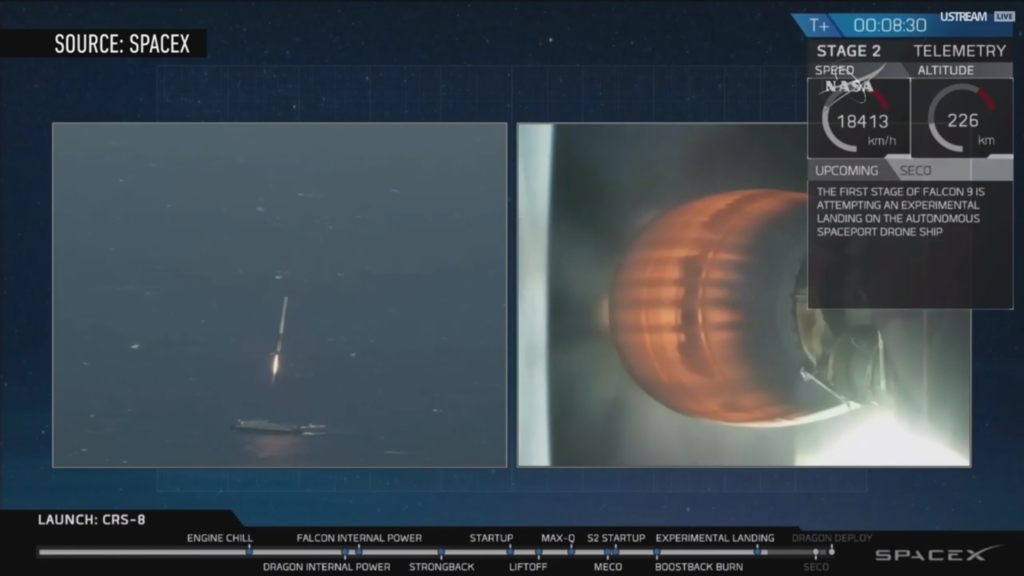SpaceXが初成功!海上ドローン船へのロケット垂直着陸
SpaceX successfully lands its rocket on a floating drone ship for the first time
It’s also the second time the company has pulled off a landing.
着陸成功は2回目です。
SpaceX has finally landed its Falcon 9 rocket on a drone ship at sea, after launching the vehicle into space this afternoon. It's the first time the company has been able to pull off an ocean landing, after four previous attempts ended in failure. Today's success is a crucial milestone for SpaceX, as it shows the company can land its rockets both on solid ground and ocean.
本日午後、遂にSpaceXがFalcon 9 ロケットを宇宙へ向けて打ち上げた後、海上のドローン船へ着陸させました。 過去4回の試みは失敗に終わりましたので、同社が海上へ戻して着陸させたのは、これが初めてです。 この成功は、SpaceXがロケットを地上と海上の両方へ着陸させられること示しており、同社にとって決定的なマイルストーンです。
- crucial - 決定的な
歴史に残る、SpaceXの海上へのロケット着陸
THE COMPANY CAN LAND ITS ROCKETS BOTH ON SOLID GROUND AND AT SEA
SpaceXは、地上と海上の両方へロケットを着陸させられる
This is the second time SpaceX has successfully landed one of its rockets post-launch; the first time was in December, when the company's Falcon 9 rocket touched down at a ground-based landing site in Cape Canaveral, Florida, after putting a satellite into space. Now that SpaceX has demonstrated it can do both types of landings, the company can potentially recover and reuse even more rockets in the future. And that could mean much greater cost savings for SpaceX.
同社が、そのロケットのひとつを打ち上げ後に着陸させたのは、これが2回目です。 昨年12月、同社のFalcon 9が人工衛星を宇宙へ送った後、フロリダ州ケープカナベラルの地上の着陸拠点へ降りてきたのが初めての成功でした。 今回、SpaceXは両方の着陸形式を遂行できて、将来さらに多くのロケットを復帰させて再利用できるということを証明しました。 そして、それはSpaceXにとって、莫大なコストの節約を意味する可能性がある。
Mastering the ocean landing is going to be important, since that’s the type of landing SpaceX will probably conduct more often. At a recent NASA press conference, Hans Koenigsmann, vice president of mission assurance for SpaceX, said the next two to three flights will involve drone ship landings. Ultimately, the company expects to land one-third of its rockets on land, and the rest at sea.
海上への着陸の習得は重要になるでしょう。 それは、SpaceXが多分、さらに頻繁に行うであろう着陸形式であるためです。 最近のNASAの記者会見で、SpaceXのミッション保証の副社長である Hans Koenigsmann が、次の2,3の飛行はドローン船への着陸に関与するだろうと言いました。 最終的に、同社は自身のロケットの3分の1を地上へ、そして残りは海上へ着陸させようとしています。
Why does SpaceX keep focusing on these ocean landings? A drone ship floating on the ocean is a harder target to hit than a large expanse of ground, since it is smaller and floating on moving water. Plus, all of SpaceX's ocean landing attempts have resulted in the rocket exploding. Still, landing at sea can be less tricky than ground landings, and the main reason has to do with fuel. To return back to Earth, the Falcon 9 has to use the fuel leftover from takeoff to reignite its engines in a series of burns. These burns help to adjust the rocket's speed and reorient the vehicle into the right position for entering Earth's atmosphere and then landing.
なぜ、SpaceXはこれらの海への着陸に注目し続けるのでしょう。海に浮かぶドローン船は地上の大きな広がりよりも狙うのが難しい。それは小さくて、水の上に浮いているためです。さらにSpaceXの海への着陸の試みの全てが、ロケットの爆発という結果になっていた。 海への着陸は地上への着陸よりは、確かにトリッキーではないが、そうするべき主な理由は燃料です。 地球へ戻ってくるために、Falcon 9は、一連の燃焼の中で、飛び立ってから、そのエンジンに再点火するまで、燃料を残しておかなくてはならない。 これらの燃焼は、ロケットの速度とその乗り物の方向を大気圏への突入と、その後の着陸のために正しい位置に調整させます。
Different types of landing techniques require different amounts of fuel, though, and that revolves around how the Falcon 9 launches. The rocket doesn't travel straight upward into space but follows a parabolic arc up and away from the launch pad. Because of this, the rocket has to go through a lot to conduct a ground landing. The vehicle has to slow down in the direction it's heading, completely turn around, and then retread the vertical and horizontal distance it's covered to get back to the landing site. That requires a lot of extra fuel.
別の着陸テクニックの種類が違えば、必要となる燃料の分量が違う。さらに Falcon 9の打ち上げ方にも関連する。 そのロケットは、まっすぐに宇宙に上がっていくのではなく、放物線を描いて打ち上げ場から飛び去ります。 その理由は、このロケットが多くの地上への着陸を行わなくてはならないからです。 その乗り物は、それが向かっていく方向に対して減速しなければならず、完全に折り返し、そして、打ち上げ拠点まで、縦と横の距離を戻ってくるのです。 それには余分な燃料が必要になるのです。
DIFFERENT TYPES OF LANDING TECHNIQUES REQUIRE DIFFERENT AMOUNTS OF FUEL
着陸テクニックが変われば燃料の分量が変わる
Ocean landings aren't as complicated as that. SpaceX's drone ship can position itself in an ideal place to "catch" the vehicle on its more natural path back to Earth. That decreases the distance the rocket needs to travel, as well as the amount of fuel needed to maneuver the Falcon 9 for landing.
海への着陸は、複雑ではない。SpaceXのドローン船は、それ自身でその乗り物を、地球へ戻る、より自然な軌道で「捕まえる」と思われる場所に行ける。 それは、Falcon 9の着陸を操縦するために必要な燃料の分量とおなじく、ロケットが移動するべき距離を少なくするのです。
For SpaceX missions that use up lots of fuel, performing a ground landing may not even be possible. Rockets that launch heavy payloads or go to a high orbit need extra speed during the initial ascent, and extra speed needs more fuel. Those Falcon 9s that have to reach extra high velocities don't have as much fuel leftover for the landing. That’s when the drone ship is the best — if not only — option for recovery.
多くの燃料を使用するSpaceXのミッションにとって、地上への着陸を実行するのは、可能ではないのかもしれない。 重たい貨物を打ち上げたり、高い軌道まで行くロケットは、初期の上昇の間に、余分なスピードを必要とします。 そして、余分なスピードは多くの燃料を必要とするのです。 それら高速に到達しなければならないFalcon 9は、着陸のために多くの燃料を持っていない。 そのためには、ドローン船が復帰のために最適な選択肢なのです、
Falcon 9 first stage on our droneship in the Atlantic after propelling the Dragon spacecraft to the @Space_Station pic.twitter.com/Cnnej7zEnt
— SpaceX (@SpaceX) 2016年4月8日
元記事は以下からどうぞ。


